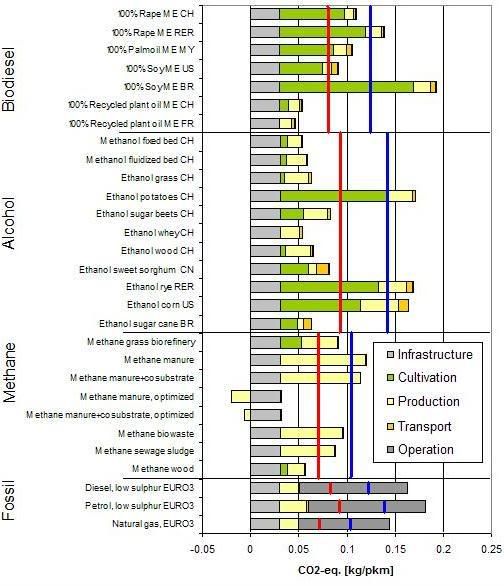jcwinnie puts up a several inarguable points against corn ethanol.
I would add one more... ethanol can be made from dozens of industrial and consumer waste by products we throw in landfills.
NONE of those waste streams compete with food production and have the potential to massively reduce disposal and transport costs.
But for whatever reason... 'corn ethanol' always finds a way to win. This is what subsidizing unsustainable energy does.
From The COB Crowd’s Triple Threat
Bill Cooke profiles Farmers’ Ethanol and how the company focuses upon sustainable production of ethanol from corn. With their approach, Wendel Dreve and Marion Gilliland claim that they are demonstrating a commitment to a triple bottom line:1. Protect the planet???
2. Help the people???
3. Make a profit - Game a point
Despite the lack of EROEI for ethanol from corn, politicians, who want to keep Big Farm happy, may be sold on the concept. “We have applied to all of the government entities: state and federal for at total of $32.2 million dollars. We’re hoping to receive somewhere in the range of $3-$10 million.”
Let’s apply the same paradigm with a critique of how well the Farmer’s Ethanol business plan could achieve a triple bottom line, shall we?
1. They may make a profit by selling the concept... bio-electricity is much more efficient than cellulosic ethanol, even more so when compared to corn ethanol... “If you put all the corn in a digester, then you would get a much better energy return on investment. You could then turn it all into electricity for export or sell as a vehicle fuel.”

2. There may be an local jobs and wealth, as there could be with other endeavors. On OTOH, a similar argument is used by Big Coal, while the quality of life in the regions being mined is actually diminished. Furthermore, diversion of corn to liquid fuel has global and regional impacts, not just local ones, and those impacts are projected to be quite negative.
Using edible food stocks and food production land to produce biofuel to keep our gas guzzlers going is foolish. This blog previously relayed a caution from GCC commentator Harvey D. “The USA got off to a wrong start with massive corn ethanol production,” wrote Harvey. “Look at what happened to the price of wheat, and other feed grains.” The Earth Policy Institute repeatedly has sounded similar warnings. And, biodiversivist informs2, “A 10 percent blend of ethanol in your full tank of gas will use enough corn to feed an adult for 40 days.”
3. Yes, protecting the environment by lessening pollution from ethanol production and especially from CAFO is a good thing. Still, should we not be asking if the carbon footprint of Farmers Ethanol really is that much smaller than that of petroleum?
GHG emissions from various transportation fuels
Cropland is incapable of absorbing as much carbon as does rain forest or even scrub land. Thus, ethanol from corn has a greater total environmental impact than many other energy strategies.
The use of combined heat and electricity from biogas is what may lead Drieve to assert that 5:1 could be achieved within 27 months. Some prior analysis does indicate that corn ethanol made with natural gas produces fewer grams of life cycle C02 per unit of energy delivered to the wheels than other seed to wheel methods.
As this blog previously noted, ethanol has “a limited ability to replace fossil fuels and should not be regarded as a ‘silver bullet’ to deal with transport emissions.”
Ethanol from corn fails European sustainability standards. As the graph illustrates, methane from manure, does better. In the above case, it is only an augmentation to the seed to wheel process.
